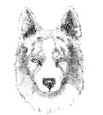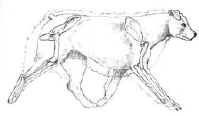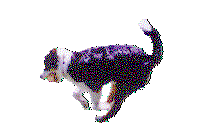|
|
|
Published by the North American
Miniature Australian Shepherd Club of the USA as adopted by the
membership in May, 2002
|
| GENERAL APPEARANCE: The Miniature
Australian Shepherd is a well-balanced herding dog of small to
medium size. Bone is also moderate and in proportion to body
size. He is attentive and animated, showing strength and stamina
with coloring that offers variety and individuality in each
specimen. Slightly longer than tall, he has a coat of moderate
length and coarseness with coloring that offers variety and
individuality in each specimen. An identifying
characteristic is his natural or docked bobtail. In each sex,
masculinity or femininity is well defined.
Disqualifications: Toy like features (i.e. domed
head, bulging eyes, fine bone)
|

Merle bitch with Tri dog in background.
Trim color is optional and not to be preferred.
|
|
CHARACTER: The Miniature Australian Shepherd is
intelligent, primarily a working dog of strong herding and
guardian instincts. He is an exceptional companion. He is
versatile and easily trained, performing his assigned tasks with
great style and enthusiasm. He is reserved with strangers, but
does not exhibit shyness. Although an aggressive, authoritative
worker, viciousness towards people or animals is intolerable.
Disqualification: Viciousness
Fault: Undo shyness
HEAD: Clean-cut, strong, dry, and in proportion to
the body. The top skull is flat to slightly rounded, its length
and width each equal to the length of the muzzle, which is in
balance and proportioned to the rest of the head. The muzzle
tapers slightly to a rounded tip. The stop is moderate, but well
defined.
TEETH: A full complement of strong,
white teeth meet in a scissor bite. An even bite is a fault. Teeth
broken or missing by accident are not penalized.
Disqualification: Undershot bites; overshot bites exceeding
one-eighth (1/8) inch
EYES: Very expressive, showing attentiveness
and intelligence. Clear, almond-shaped, and of moderate size, set
a little obliquely, neither prominent nor sunken, with pupils
dark, well defined and perfectly positioned. Color is brown, blue,
amber or any variation or combination thereof including flecks and
marbling.
|
EARS: Set on high at the side of the head,
triangular and slightly rounded at the tip, of moderate size with
length measured by bringing the tip of the ear around to the
inside corner of the eye. The ears, at full attention, break
slightly forward and over from one-quarter (1/4) to one-half (1/2)
above the base.
Severe Faults: Prick or hound-type ears
|

Prick ear |

Hound ear
|
| NECK AND BODY: The neck is
firm, clean and in proportion to the body. It is of medium length
and slightly arched at the crest, setting well into the shoulders.
The body is firm and muscular. The topline appears level at a
natural fore-square stance. The chest is deep and strong with ribs
well sprung. The loin is strong and broad when viewed from the
top. The bottom line carries well back with a moderate tuck-up.
The croup is moderately sloping, the ideal being thirty (30)
degrees from the horizontal. Tail is straight, not to exceed three
(3) inches, natural bobtail or docked. |
| FOREQUARTERS: The shoulder blades
(scapula) are long and flat, close set at the withers,
approximately two fingers width at a natural stance, and are well
laid back at an angle approximately forty-five (45) degrees to the
ground. The upper arm (humerus) is attached at an approximate
right angle to the shoulder line with forelegs dropping straight,
perpendicular to the ground. The elbow joint is equidistant from
the ground to the withers. The legs are straight and powerful.
Pasterns are short, thick and strong, but still flexible, showing
a slight angle when viewed from the side. Feet are oval shaped,
compact, with close-knit, well-arched toes. Pads are thick and
resilient; nails short and strong. Dewclaws may be removed. |

|
| HINDQUARTERS: Width of
hindquarters approximately equal to the width of the forequarters
at the shoulders. The angulation of the pelvis and upper thigh
(femur) corresponds to the angulation of the shoulder blade and
upper arm forming an approximate right angle. Stifles are clearly
defined, hock joints moderately bent. The metatarsi are short,
perpendicular to the ground and parallel to each other when viewed
from the rear. Feet are oval shaped, compact, with close-knit,
well-arched toes. Pads are thick and resilient; nails short and
strong. Rear dewclaws are removed. |

|
|
COAT: Of medium texture, straight to slightly
wavy, weather resistant, of moderate length with an undercoat. The
quality of undercoat varies with climate. Hair is short and smooth
on the head, outside of ears, front of forelegs and below the
hocks. Backs of forelegs are moderately feathered; breeches are
moderately full. There is a moderate mane and frill, more
pronounced in dogs than bitches.
Severe fault: Non-typical coats
COLOR: All colors are strong, clear and rich. The recognized
colors are blue merle, red (liver) merle, solid black, and solid
red (liver) all with or without white markings and/or tan (copper)
points with no order of preference. The blue merle and black have
black pigmentation on nose, lips and eye-rims. Reds and red merles
have liver pigmentation on nose, lips and eye rims. Butterfly nose
should not be faulted under the age of one year. On all colors the
areas surrounding the ears and eyes are dominated by color other
than white. The hairline of a white collar does not exceed the
point at the withers.
Disqualifications: Other than recognized colors, white
body splashes. Dudley nose |
| GAIT: Smooth, free and easy;
exhibiting agility of movement with a well-balanced,
ground-covering stride. Fore and hind legs move straight and
parallel with the center line of the body; as speed increases, the
feet, both front and rear, converge toward the center line of
gravity of the dog, while the topline remains firm and level. |

|
|
SIZE: Height for dogs and bitches is
14 inches up to 18 inches at the top of withers. Quality not to be sacrificed in
favor of size within the guidelines of this breed standard. Severe fault under
14 inches and over 18 inches.
Disqualification's:
-
Monorchidism and Cryptorchidism
-
Toy like features (i.e. domed head, bulging eyes,
fine bone)
-
Other than recognized colors, white body splashes,
Dudley nose
-
Viciousness ü Undershot bites; overshot bites
exceeding one-eighth (1/8) inch
As adopted by the NAMASCUSA Board
Of Directors 5/02 |
|
For a more detailed look at the Breed Standard go to Breed Standard Guidelines
Booklet
|
|
"Drawings from Victoria and Christina Mistretta's book The
Structure and Movement of the Australian Shepherd. Permission to use granted
01/01. All drawings are Copyright protected. All rights reserved. No picture may
be reused or copied without written permission from authors."
The
Structure & Movement of The Australian Shepherd by Victoria &
Christina Mistretta.
$25.00 (Postage included) * note: add $2.00 for Canadian and $5.00 postage for
international orders. Send order to: Victoria Mistretta, 3167 Dodge Rd, White
City, OR, 97503 541-826-6598 |

|
|